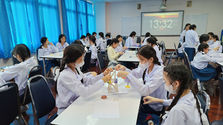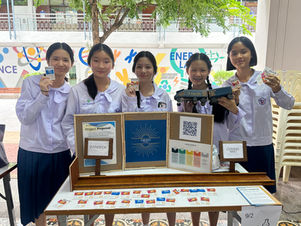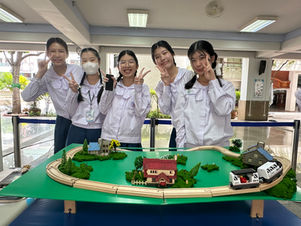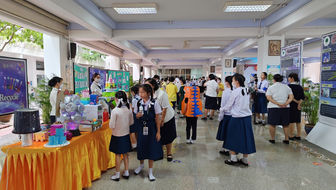School events
2024/25
English Fair - 2024/25
This year's English Fair embraced the exciting theme of International Day, where students from grades 7 to 12 were tasked with choosing a country to represent. Each class created a unique meal or snack inspired by the selected country to sell at their stalls, offering a delicious taste of global culture. In addition to this, both students and teachers took part in the fun by dressing up in costumes that represented various countries from around the world.
The highlight of the day was the International Day parade, which invited all students from Grades 1 to 12 to join in the festivities. The parade featured an eclectic mix of outfits, from the graceful traditional saris of India to the playful Smurfs, originating from Belgium, and even a kilted bagpiper bringing the spirit of Scotland to life.
To further immerse themselves in the international theme, students decorated their booths to reflect their chosen countries and showcased their creativity through multi-lingual menus in Thai, English, and the language of the country they represented. The atmosphere was one of joyful energy, with vibrant colours, laughter, and an undeniable sense of global unity. Overall, it was a day filled with cultural celebrations, delicious food, and unforgettable moments.
Math Challenge- 2024/25
The Math Problem-Solving Challenge for Grades 7-9 is a dynamic and engaging competition designed to foster teamwork, creativity, and critical thinking. Students will work in teams to solve math-based problems, make strategic decisions, and build structures that test their engineering and problem-solving skills. The challenge consists of two parts:
Part 1: Math Quiz and Budgeting
In the first part of the challenge, each team will participate in a short math quiz. The quiz will assess their mathematical abilities, and the points they earn will determine how much "budget" they have to spend on supplies for Part 2. This portion of the activity teaches important life skills such as budgeting, decision-making, and teamwork, as students must allocate their points wisely to secure the materials needed for their structure.
Part 2: Building the Structure
Armed with their points and a set of materials including popsicle sticks, elastic bands, and tape, teams will design and build the tallest structure possible that can also support the most weight. This segment challenges students to apply mathematical concepts in a practical way, encouraging innovation, collaboration, and strategic thinking.
Final Round:
The most successful team from each classroom will advance to the final round, where they will compete against other teams from Grades 7-9. In the final, the students will face an exciting variation of the original challenge, testing their skills in a more competitive and creative environment.
This event is not only about math—it’s about learning how to work together, manage resources, and apply problem-solving techniques in a fun and competitive setting.
PBL Term 1 - 2024/25
For the term one PBL project, students were tasked with finding solutions to deliver two of the SDGs:
-
SDG 11 - Sustainable Cities and Communities
-
SDG 12 - Responsible Consumption and Production
-
Grade 7 students focused on energy and green buildings. Some of the projects included solar-powered air-conditioning and water turbines to generate electricity.
-
Grade 8 students worked on solutions for waste management. These solutions included recycling, reusing and composting to generate new uses from trash.
-
Grade 9 students tackled transport. They looked at the current public transport systems and proposed ideas to make them greener and more energy-efficient. They also proposed biofuels and new underground sortation systems for delivering packages to the local community.
Science Week - 2024/25
This Science Day we focused on showing interactive projects that sisters, students and teachers could engage with while visiting our stands.
Science
-
Grade 7 students learned which periodic table elements are conductors and which are not. They tested this using various elements and props; sulfur, carbon, aluminium, wood, nails & paperclips. We thought it would be fun to test what unexpected and weird objects can conduct electricity. We discovered that by inserting pieces of zinc and copper into a potato or a tomato and connecting them with wires, enough energy is generated to light up a bulb!
-
Grade 8 students presented the water, oil, and food colouring experiment. This experiment demonstrates the principle "like dissolves like," which states that solutes tend to dissolve in solvents with similar polarity. Procedure: fill 3/5 of a clear cup with water. Then, add a layer of oil. The oil will not mix with the water because water is polar and oil is nonpolar. The oil will stay above the water because oil has a lower density than water. Next, put some drops of food colouring into the oil. The food colouring will not mix with the oil because food colouring is polar. Instead, it will form tight balls. You can use an implement to push the balls of food colouring into the water. Since food colouring and water are both polar, the food colouring will mix, creating ribbons of colour.
-
In Grade 9, students have been studying about light and refraction. Students used three torches with red, green and blue lights. When different wavelengths of light are mixed together, the light reflected from the surface changes colour. This is amplified when an object is placed in front of the light source, causing different colour shadows.





























































































